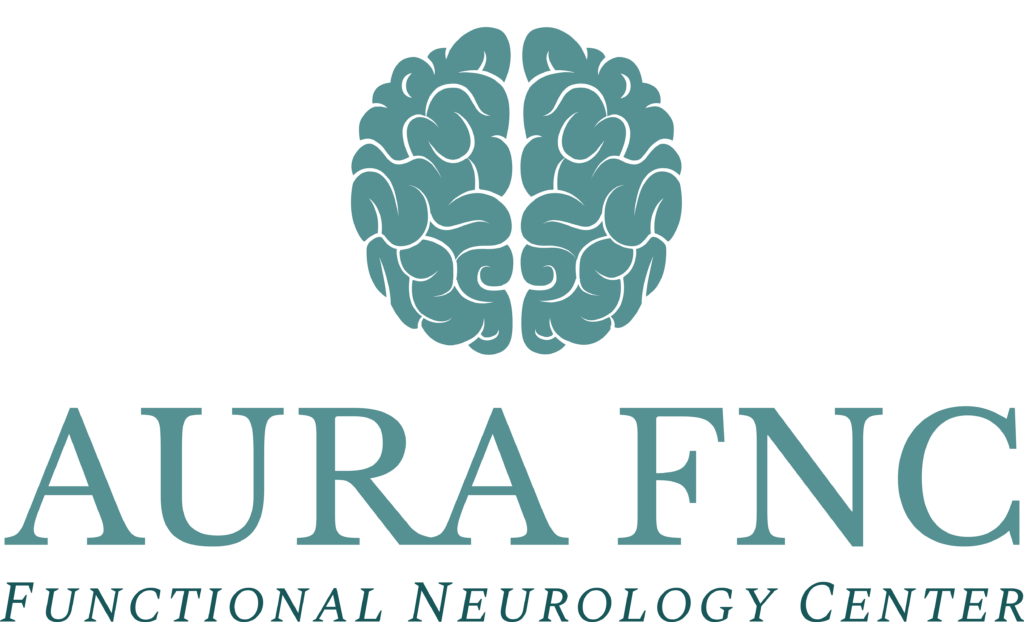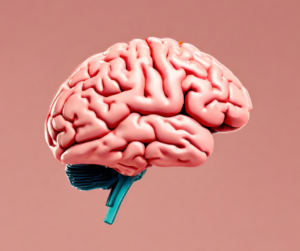Learn the intricacies of migraine aura, its causes, symptoms, and groundbreaking treatments. Leverage neurological insights for better migraine management from Dr. Diana Tyler.

Dr. Diana Tyler DC, DACNB
Founder of Aura Functional Neurology Center. Board Certified Chiropractic Neurologist and migraine specialist. Graduate of Palmer College of Chiropractic and Diplomate of the American Chiropractic Neurology Board.
Table of Contents:
- Definition of Migraine Aura
- Demystifying Migraine Aura: An In-depth Look
- Sensory Changes and Associated Fears of Aura
- Science Behind Migraine Aura: Cortical Spreading Depression
- Innovative Treatment: Brain Rehabilitation for Migraine Aura
- Harnessing Neuroplasticity: New Migraine Aura Management
Definition of Migraine Aura
Visual disturbances are one of the most common manifestations of migraine aura. People experiencing a visual aura may see bright lights, blind spots, or colored spots. They may also experience tunnel vision or double vision. Physical sensations such as tingling or numbness in the face or limbs are another common feature of migraine aura. In some cases, individuals may even have difficulty speaking or finding the right words to express themselves.
There are various subtypes of migraines that can involve auras. These include but are not limited to hemiplegic migraine, retinal migraine, and typical aura without headache. Each subtype has its own unique set of symptoms and may require different approaches to treatment.
In order to accurately diagnose and manage migraine aura, it is important for individuals to recognize these sensory changes as potential warning signs. By understanding the definition of migraine aura and its associated sensory disturbances, individuals can seek appropriate treatment and better manage their migraine experience.
Demystifying Migraine Aura: An In-depth Look
Migraine is a neurological condition that affects millions of people worldwide. It is characterized by recurring headaches that can be severe in intensity and cause light and sound sensitivity with associated neurological symptoms.
‘Over 25% of migraine patients also experience a phenomenon known as migraine aura’. Shankar Kikkeri N, Nagalli S. Migraine With Aura. [Updated 2022 Dec 6]. In: StatPearls [Internet]. Treasure Island (FL): StatPearls Publishing; 2023 Jan-. Available from: https://www.ncbi.nlm.nih.gov/books/NBK554611/
By understanding this aspect of migraines, patients can better understand and manage their symptoms.
Symptomatic Changes: The Phenomenon of Migraine Aura
Migraine aura refers to a series of sensory disturbances or changes in perception that occur before or during a migraine headache. These sensory changes can cause temporary disturbances in hearing, smell, taste, vision, and sensory/motor function. These symptoms occur in the prodrome phase of migraine (a few hours leading up to head pain) and typically develop gradually and can last for several minutes to an hour. Not all migraine sufferers experience aura symptoms, but for those who do, it can be a significant part of their migraine episodes because of the temporary loss of function of multiple systems within the body- including visual and sensory. Most importantly, it is also a warning sign that a migraine attack is around the corner.
Common Symptoms of Migraine Aura
Migraine aura symptoms vary from person to person, but some of the most common manifestations include visual disturbances. These might appear such as zigzag lines, flashes of lights, shimmering lights, temporary loss of vision, blind spots in one eye (or both), and tunnel vision. This can significantly impair the ability to see therefore affecting work-life as well as decreasing general safety, as this can occur even while driving or performing a dangerous task. Typically, after the visual and sensory disturbance returns to normal, the headache starts shortly afterward. If you aren’t sure why you might be getting these symptoms, don’t forget that you can also get migraine aura from not eating.
Sensory Changes and Associated Fears of Aura
Apart from visual disturbances, individuals may experience additional sensory changes, such as tingling and numbness in the face, hands, or other regions of the body, and altered sense of touch or temperature perception. In these cases, often, the symptoms will be unilateral or occur on one side of the body. It is not uncommon to hear that the first instance of these symptoms typically includes a visit to the local emergency room due to the fear of having a more serious neurological event such as a stroke.
Language and Speech Difficulties During Migraine Aura
Just as with sensory changes mimicking stroke-like symptoms, some individuals may have associated language and speech difficulties. Common symptoms include struggling with finding the right words or experiencing slurred speech, known as dysarthria, during a migraine aura. This can be frustrating and may cause communication challenges as well as serve as an early symptom of an upcoming migraine attack.
Research has shown that migraine aura is caused by the electrical activity of the brain, known as Cortical Spreading Depression (CSD). Understanding the science behind CSD can provide valuable insights into the mechanisms of migraines and how they affect the brain.
Science Behind Migraine Aura: Cortical Spreading Depression
Cortical spreading depression refers to a wave of electrical and chemical changes that spread across the cortex of the brain. This wave starts in one area of the brain (typically the occipital region) and gradually expands, affecting nearby regions. It is characterized by a period of intense neural activity followed by a period of suppressed neural activity.
The wave of CSD moves at a relatively slow pace, typically around 3 to 5 millimeters per minute. It is important to note that CSD is not exclusive to migraines and can also occur in other neurological conditions (such as seizure disorders) and brain injuries.
CSD and Migraine Aura
In the context of migraines, CSD is believed to be a crucial factor in the development of migraine aura. The electrical and chemical changes associated with CSD disrupt normal brain function and give rise to sensory disturbances and other symptoms experienced during the aura. This is caused by a transient disruption in the balance of ions across brain cells. This disrupts the normal electrical activity of neurons and affects their ability to transmit signals effectively. As a result, individuals may experience visual disturbances, sensory changes, and other aura symptoms discussed above. This is considered an altered brain state of excitation.
What Causes Cortical Spreading Depression
‘Research has found several factors contribute to the initiation of Cortical Spreading Depression and activating of migraine aura symptoms in individuals.’ Lauritzen M, Dreier JP, Fabricius M, Hartings JA, Graf R, Strong AJ. Clinical relevance of cortical spreading depression in neurological disorders: migraine, malignant stroke, subarachnoid and intracranial hemorrhage, and traumatic brain injury. J Cereb Blood Flow Metab. 2011 Jan;31(1):17-35. doi: 10.1038/jcbfm.2010.191. Epub 2010 Nov 3. PMID: 21045864; PMCID: PMC3049472.
In the fascinating realm of neuroscience, one of the intriguing phenomena is the intricate interplay between brain cells and ions. Brain cells, called neurons, speak to each other through the exchange of electrical signals. These electrical signals are generated and propagated through the movement of ions in the cell membrane.
One key factor in CSD is the imbalance of ions, particularly potassium and calcium, within brain cells leading to an increase in potassium, then depolarization, causing neurons to become hyperactive. This hyperactivity is followed by a wave of suppressed neural activity.
These minuscule charged particles play a crucial role in transmitting electrical signals within the brain, ensuring the smooth functioning of our cognitive processes. Various neurological disorders, including migraine, have been genetically linked to abnormalities in these ion channels.
The Contributing Role of Glutamate
The second key contributor to CSD and Migraine Aura is Glutamate, an important excitatory neurotransmitter. During the hyperactive phase of CSD, there is an excessive release of glutamate, which can lead to excitotoxicity. Excitotoxicity refers to the damage caused to neurons due to prolonged exposure to high levels of glutamate, resulting in their dysfunction or even death. This is why patients with migraines should avoid MSG (monosodium glutamate) containing foods that are commonly found in food additives in the grocery aisle.
The third contribution to migraine aura symptoms from CSD is the impact on neurovascular coupling. This refers to the connection between neural activity and blood flow in the brain. During CSD, the disrupted neural activity affects the regulation of blood vessels in the affected region. This leads to changes in blood flow, including vasodilation (widening of the blood vessels) and vasoconstriction (narrowing of the blood vessels). The changes in blood flow associated with CSD can trigger additional symptoms, such as visual disturbances and sensory changes. The altered blood flow may also contribute to the throbbing pain experienced during a migraine headache.
Innovative Treatment: Brain Rehabilitation for Migraine Aura
While more research is always needed on migraines or migraine aura, several regions of the brainstem and cortex are involved. Neurological rehabilitation treatment approaches to migraine headaches without aura (MO) and Migraine with Aura (MA) can help manage the condition and alleviate symptoms. Understanding that migraine is an altered brain state of excitation, the goal of brain rehabilitation is to provide stability within these aberrant regions.
Brain rehabilitation techniques involve repetitive and targeted activities that stimulate specific neural circuits. This activation of neurons and the associated synaptic plasticity can promote the stabilization of ion channels. Regular and focused neural activity can reinforce the connections between neurons and help maintain the proper functioning of ion channels.
Understanding How Brain Rehabilitation Stabilizes Ions
One way to stabilize ions is by using neurotransmitters (which are naturally produced by regions of the brain and brainstem). Neurotransmitters play a critical role in regulating ion channel activity. Brain rehabilitation often involves exercises and therapies that promote the release and balance of neurotransmitters, which stabilizes dysfunctional ion channels.
The second way includes modulation of gene expression. Neuroplasticity, the brain’s ability to reorganize and adapt, involves changes in gene expression. Brain rehabilitation can influence gene expression patterns, leading to the production of specific proteins and ion channel components that contribute to their stability. By promoting the expression of genes associated with ion channel regulation, brain rehabilitation can help stabilize their function.
Stabilization Through Neuronal Networks
The third way to stabilize ion channels is through structural changes in neuronal networks. Rehabilitation activities that challenge the brain, like learning new skills or tasks, can trigger the formation of new synapses or strengthen existing ones. These structural changes can enhance the stability of ion channels by creating a more robust and efficient network for electrical signal transmission.
The fourth way includes rehabilitation of dysfunctional ion channels that have occurred due to neurodegenerative processes or previous injuries such as a Traumatic Brain Injury (TBI) or Concussion (mTBI). Neurological rehabilitation interventions have neuroprotective effects, safeguarding neurons from further damage or degeneration. By preserving neuronal health, brain rehabilitation can help prevent the disruption of ion channels that contribute to migraine and CSD.
Harnessing Neuroplasticity: New Migraine Aura Management
Overall, brain rehabilitation techniques capitalize on the brain’s inherent plasticity and adaptive capabilities to promote stability in ion channels. By engaging in activities that activate neurons, balance neurotransmitter activity, modulate gene expression, induce structural changes, and provide neuroprotective effects, brain rehabilitation can contribute to the stabilization of ion channels and support overall brain function. Stabilization of ion channels through the use of neuroplasticity leads to a reduction in Cortical Spreading Depression (Aura) and migraine headaches.
By actively engaging in brain-stimulating activities and therapies that support overall brain health, migraine sufferers can take proactive steps toward regaining control over their symptoms and improving their quality of life. As research in this area continues to evolve, the hope is that new insights will pave the way for even more targeted and effective treatment options for individuals living with migraine aura.







